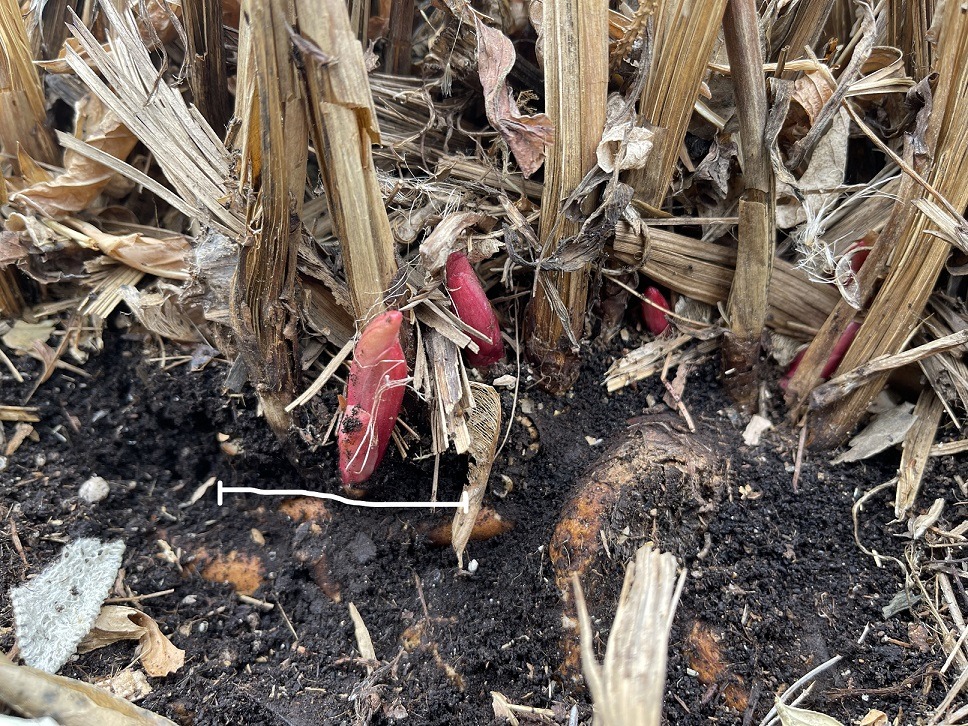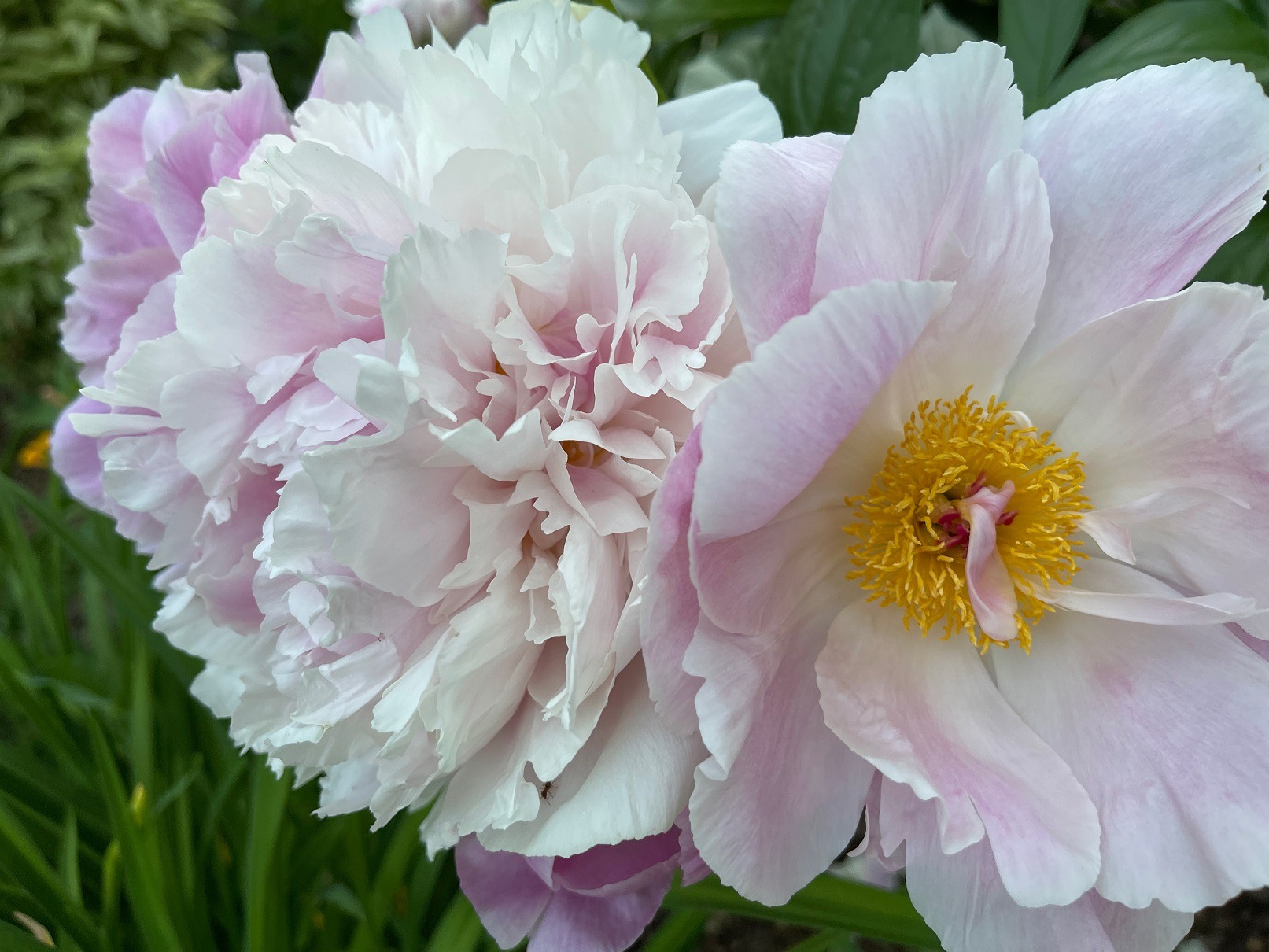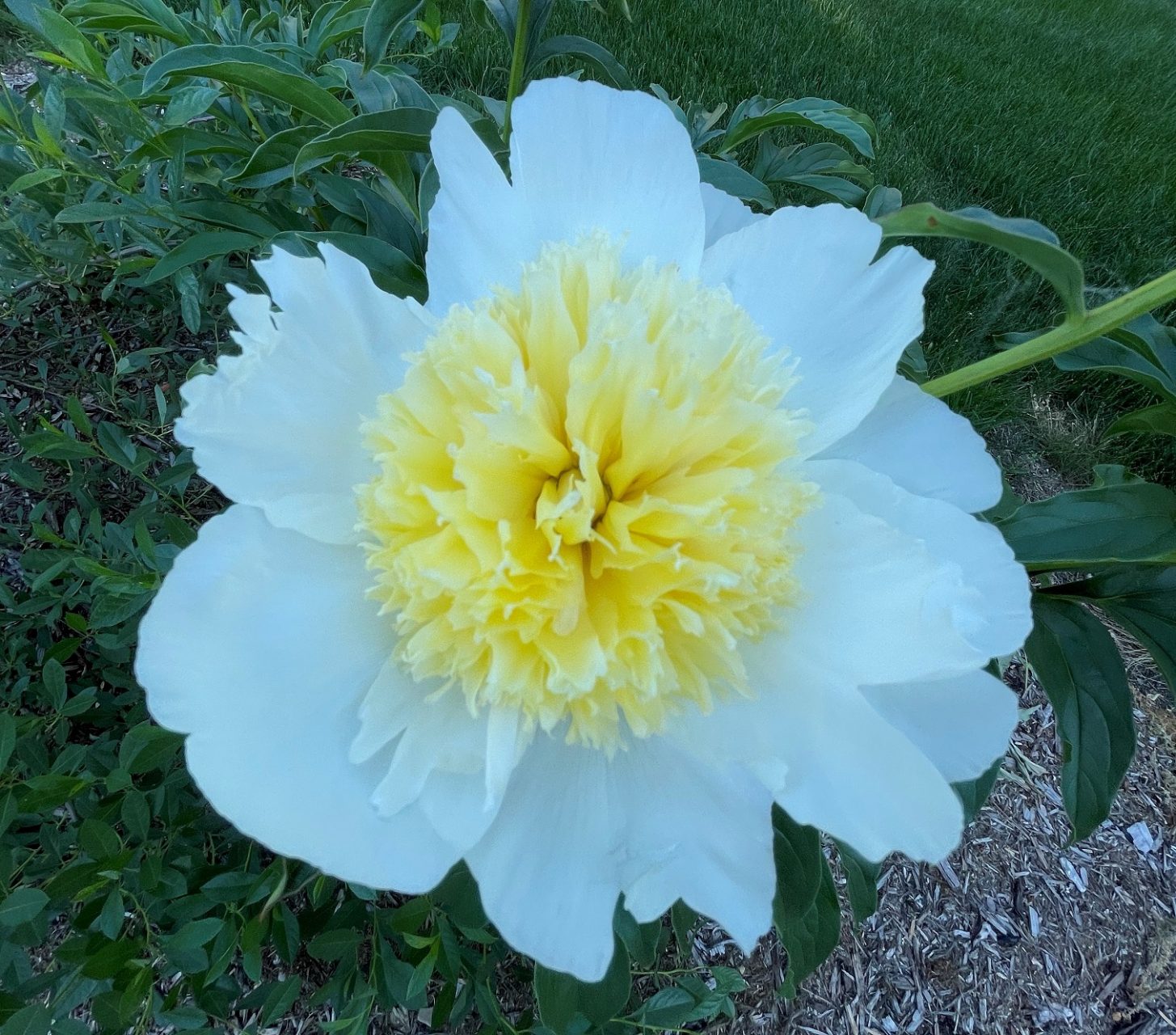
Peonies are a northern perennial gardener’s standby.
They are tough, hardy, drought-tolerant, and not to mention outstandingly beautiful on the plant and as fresh cut flowers. Can you tell I love this perennial??
Being a spring flowering perennial, peonies are classified as early, mid, and late spring bloomers.
But sometimes their flowers don’t show up, so let’s talk about the different types of Peonies, and then explore eight reasons why Peonies don’t bloom. While we’re at it, we’ll touch on how and when to plant a Peony.
Five Different Types of Peonies
Peonies are divided into five distinct groups: Garden Peonies, Tree Peonies, ITOH/Intersectional Peonies, Fernleaf Peonies, and Woodland Peonies.
Here they are in more detail:
Garden Peonies
Garden peonies, also known as herbaceous peonies, have a rounded, shrub-like shape. They are very floriferous with a wide variety of flower shapes. They are vigorous, very hardy, and many varieties are fragrant. Garden Peonies are herbaceous perennials, which means that they grow fresh from the ground each spring. Sometimes they need wire support to stand straight under the weight of their heavy blossoms. Garden Peonies range in hardiness from zone 3-8.
Tree Peonies
Tree peonies have a shrub or tree-like shape, depending on the plant hardiness zone they are growing in. They can grow over 4 feet tall in warmer climates like the lower mainland of British Columbia and southern Ontario, but they stay shorter in cooler plant hardiness zones. Many Tree Peonies sport huge semi-double blossoms in unique colour combinations of coral, pink, orange, purple, yellow, or white. Tree Peonies are not herbaceous – they don’t grow from the ground each spring. The new growth comes from their woody stems, so don’t cut them back in the fall. Tree Peonies are hardy in zones 4-9.
ITOH Peonies / Intersectional Peonies
ITOH peonies are a hybrid cross between garden and tree peonies. Tree peony scions (stems with at least 1 bud) are grafted onto the rootstock of herbaceous (garden) peonies to make this combination. They have large semi-double flowers of unique flower colours not seen in garden and tree peony classes, a long blossom period, and they are vigorous growers. ITOH Peonies are hardy from zone 4-8.
Fernleaf Peonies
Fernleaf peonies, also known by their Latin name, Peony tenuifolia, have fern-like leaves and distinct dark red flowers. Fernleaf Peonies are quite expensive because they are slow growing and a little challenging to establish, but once they get going, they are hardy and beautiful. These Peonies are rated as a zone 3-8 perennial and sometimes tolerate a hardiness zone as low as a zone 2.
Woodland Peonies
Woodland Peonies are early spring blooming peonies with small, single blossoms. These are less common and infrequently used in perennial gardens. Woodland Peonies can tolerate more shade than the other varieties, working best in deciduous woodland gardens. Woodland Peonies grow in plant hardiness zones 3-4.

Why Won’t My Peony Bloom?
For home gardeners, Peonies are all about the blooms. They kick off early garden colour and fragrance in the spring and make delightful cut flowers. When they don’t bloom, it’s disappointing.
Let’s look at eight common causes for Peonies to experience decreased blooming or a complete lack of flowers.
1. The Peony Crown Depth is out of Whack
Getting Peonies established after transplanting is the trickiest part of growing Peonies and this is where most of the trouble goes back to when there is a lack of blooming.
Peonies need extra care, both for the Peony that was divided and the newly planted Peony, because they don’t like having their roots disturbed.
Peonies have tuberous roots. Tuberous roots are different from potatoes, which are tubers. Tuberous roots have enlarged structures whose function is nutrient storage. They produce stems on one end and develop branching roots on the other. The stems then grow nodes and buds.
Dahlias, daylilies, irises, and sweet potatoes also have tuberous roots.
Peonies are sensitive about how deep their crowns are planted, and incorrect crown placement can affect blooming. Peonies will fail to flower if the crown is too shallow, and they will not blossom if the crown is too deep, either.
What is a Peony crown?

A Peony crown is the point where the stems emerge from the tuber.
Correct crown planting depth varies with the type of Peony:
- The planting depth for Garden, Intersectional (ITOH), Fernleaf, and Woodland Peonies is quite shallow. Place the crown 4-5 cm (1.5–2”) below soil level.
- Tree peonies prefer a surprisingly deeper crown placement. Plant the graft union 10-15 cm (4- 6”) below the soil level. The graft union is a prominent bulge on the stem near the root.
2. The Peony is too Young to Flower
Peonies, like all perennials, take a few years to establish from the newly planted tuberous root. As a veteran perennial grower, I have always said that the third year is a perennial’s magical year. That’s when they are established, and you see them flourish and really start to show off their stuff.
Typical perennial growth and establishment patterns look like this:
- Year 1: Perennials Sleep
- Year 2: Perennials Creep
- Year 3: Perennials Leap

In the First Year of Planting, Perennials Sleep:
The first year that a perennial is planted is spent strengthening its root system and adapting to its new growing environment.
You will not see much growth the first year a Peony is planted. Actually, you probably won’t see any growth. All Peonies, except for Tree Peonies, grow fresh from their tuberous roots each spring, and you will have purchased your Peony after it has completed that growth.
Peonies can be planted any time of the growing season, but each season has its own unique factors to consider. Because of their difficulty establishing, fall is the simplest time to transplant Peonies. Fall is cooler and metabolic demands are decreased BUT here’s the rub — most of the cool and unique varieties are available in spring.
Whether you’re planting Peonies in the spring, summer, or autumn; plant them gently into a generous hole where the soil drains well. No fertilizer or bonemeal is needed at the time of transplanting because their tuberous roots hold sufficient nutrient storage. Adding fertilizer at this stage could negatively affect blooming.
Gently fill the hole to ground, carefully placing the crown at the correct depth, and keep the soil evenly moist, but not wet. Too much moisture will cause the root to rot.
In the Second Year after Planting, Perennials Creep:
Following their first winter, Peonies will grow a little larger as they continue to fortify their root system and become a part of its new garden ecosystem. You may see an additional stem or two sprout up.
It is a good idea to trim off any buds in the second year so they can continue to mature.
Check and maintain an even, but not wet, moisture level.
In the Third Year after Planting, Perennials Leap:

The third year is when most perennials really start to show off their glory. You will see another stem or two, and you can keep the buds on, if they have any. If you don’t see any blossoms on your Peony this year, it’s not unusual; they just need more time to grow.
The Peony should be established well enough to not require any supplemental watering, especially if your garden has mulch. If the weather is extremely dry, monitor them more closely for water.
Related: What is Mulch? Making Gardening Magic with Mulch
3. The Peony has had too Much Nitrogen Fertilizer
Peonies are one of those relatively low or no-care perennials.
Peonies are nutritionally self-sufficient because of their nutrient dense tuberous root systems and don’t have a high requirement for fertilizer. They are so self-sufficient that they are easy to over fertilize.
I don’t recommend fertilizing Peonies at all. When Peonies have too much nitrogen, that’s the first number in the fertilizer sequence on fertilizer labels, they revert to developing green leafy growth and bud development stops.
Related: How to Understand Fertilizer Labels
4. The Peony Flower Buds Died
Sometimes Peonies allow their flower buds to die in response to high stress levels.
Peonies are tough and hardy plants for northern climates, but sometimes crazy spring weather events cause a plant to slough its buds. Plants will stop blooming and funnel their energy and nutrients to support survival.
Typical stress factors to prompt Peony bud death include:
- Hard, late frosts that freeze out destroy young buds.
- Unseasonably hot, dry spring weather combined with a lack of moisture can cause the buds to dry up and turn brown.
- Infections like gray mould (botrytis) is another cause of lost buds. Peonies fighting off infections direct their energy heal, or the condition compromises the Peony to the point that it isn’t able to bud.
5. The Peony was Recently Divided
Peony roots can grow massive storage systems that extend deep and wide. Whenever their fleshy roots are disturbed, Peonies require time to readjust depending on how much root was taken.
It’s not an easy thing to divide Peony roots — they are thick and fibrous and the tuberous root of the parent Peony may sustain more damage than anticipated.
Any time that a Peony has had injury to its roots, it needs time to re-establish itself, and it may stop blooming for a year or two to make that happen.

6. The Clump is too Large or Overcrowded
This is another Peony root related issue. When Peony clumps age and become crowded, blooming can fade because the crown gets overcrowded. When this happens, the crown can look like a bumpy mass that might be raised out of the soil.
To fix this, try to gently remove some roots at the perimeter edges. It’s better to take some roots off the edges than dig up the entire Peony root and divide it above the ground.
Late August and early September are the best times to do this. Spades work well for trimming off Peony roots. Before you start this type of ‘surgery’, wash your tools in hot soapy water to limit the spread of disease borne infections.
It also helps to cut back the stems to visualize the crowns and root system better. Less foliage also decreases metabolic demands on transplanted roots.
Slice straight down; the roots may go very deep and try your best not to injure the roots by hacking at them.
Replant the roots or share them with a friend.
7. The Peony isn’t Getting Enough Sun
Peonies are sun lovers. They require a daily minimum of eight hours of direct sunshine to get them to thrive.
Whenever you plant a Peony, choose a location that will stay sunny for the long haul. As tress and shrubs grow and yards mature, they get shadier. Try to find a spot for your Peony that will remain unaffected by yard development over the years.
8. The Peony Foliage was cut Back Before it Turned Brown in the Fall
Once the Peony flowers are spent, clip off the old blossoms.
At this point, Peonies take on the role of a shrub. Their unique compound lobed leaves provide structure and a backdrop for other blooming perennials and annuals for the rest of the growing season.
From a horticultural perspective, Peonies continue to metabolize and feed their roots late into autumn as they prepare for the coming winter and next spring. Let the foliage die back naturally to allow the maximum input of nutrients into their root storage system.
Try to avoid cutting off any of the foliage as it yellows. Removing stems and leaves too early could strip the Peony of essential nutrients, and this lack of nutrition could lead to weak or no flowering at all.
Looking for more flower ideas for a sunny garden?

Here are some other blogs that you may find applicable for your sunny garden:
- 10+ Amazing Annual and Perennial Flowers to Grow in Full Sun
- The Best Smelling Flowers to Grow in Your Garden
- The Best Secrets to Making Cut flowers Last
Conclusion
Peonies are a low maintenance, lovely perennial that can live through generations. Peonies are perfectly suited to withstand a wide variety of northern weather events and present few problems to gardeners.
If your Peony is blooming less or has stopped altogether, check out the above causes and you should find the culprit.

©Sharon Wallish Murphy, ©Gardening with Sharon































